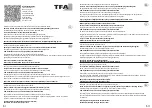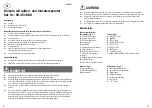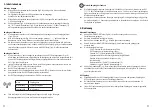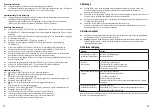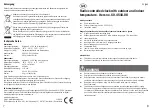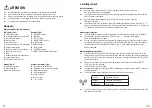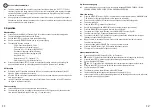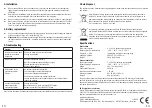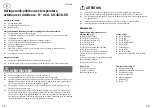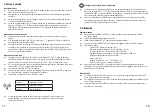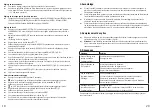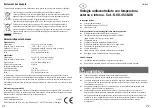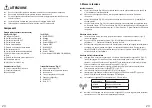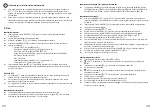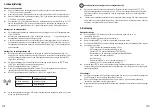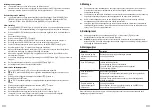
ATTENTION
Unauthorized repairs, alterations or changes to the product are prohibited.
Do not expose the device to extreme temperatures, vibrations or shocks.
Clean the instrument with a soft damp cloth. Do not use solvents or scouring agents.
The base station is only suitable for indoor use. Protect it from moisture!
The transmitter is splashproof, but not watertight
Elements:
Radio-controlled clock (base station)
LCD display (Fig.1)
Buttons (Fig.2)
A
- Time with seconds
A
- MODE/SET button
B
- Symbol Daylight Saving Time (DST)
B
-
button
C
- DCF reception symbol
C
-
/ button
D
- Alarm symbol
D
- ALARM ON/OFF button
E
- Day of the week
E
- RESET button
F
- Reception symbol for the transmitter
F
- SNOOZE button
G
- Outdoor temperature
G
- ALERT button
H
- Battery symbol for the transmitter
H
- RF SEARCH button
I
- Upper/lower alarm level
I
- ALARM (MON-FRI/MON-SUN) switch
K
- Date
L
- Battery symbol for the base station
M
- Indoor temperature
N
- AM/PM in 12-hour-format
Housing (Fig.2)
Outdoor transmitter (Fig.3)
K
- Wall mounting hole
A
- Transmission indication LED
L
- Stand (fold out)
B
- Indication of the outdoor temperature
M
- Battery compartment
C
- Battery compartment
D
- Wall mounting hole
E
- Stand (fold out)
F
- RESET button
G
- °C/°F button
1. Getting started
Insert the batteries
Open the battery compartment (Fig.2-M) of the base station and insert four new
AA 1.5V batteries, polarity as illustrated.
The device will alert you with a beep and all LCD segments will be displayed for a short moment.
Close the battery cover again.
Open the battery compartment (Fig.3-C) and insert two new AAA 1.5 V batteries,
polarity as illustrated.
The indicator light (Fig.3-A) lights up briefly. The outdoor temperature is shown. Press the °C/°F
button in the battery compartment (Fig.3-G) of the transmitter, to change between °C (Celsius) or
°F (Fahrenheit) as temperature unit. Close the battery cover again.
Outdoor values reception
The base station will scan the outdoor temperature and the reception symbol (Fig.1-F) flashes.
If the reception of outdoor temperature (Fig.1-G) fails, “- -. - “appears on the display.
Check the batteries and try it again.
You can also start the outdoor transmitter search manually later (e.g. if the transmitter is lost or if
the batteries are changed). Press and hold the RF SEARCH button (Fig.2-H) on the base station
for three seconds. Then press the RESET button (Fig.3-F) in the battery compartment of the
outdoor transmitter.
Radio-controlled time reception
The clock will now scan the DCF frequency signal and the DCF symbol (Fig.1-C) flashes on the
display. When the time code is successfully received after some minutes, the radio-controlled time
and the DCF symbol will be shown steadily on the display. In Daylight Saving Time DST (Fig.1-B) is
shown on the display.
If there is no reception, you can start the initialisation manually. Press and hold the
/
(Fig.2-C) button for 3 seconds.
The DCF symbol (Fig.1-C) flashes.
Interrupt the reception by pressing the
/ button again for three seconds. The DCF reception
symbol disappears.
The DCF reception always takes place daily at 3:00 o’clock in the morning.
If the clock cannot detect the DCF-signal (e.g. due to interference, transmitting distance, etc.), the
time can be set manually.
flashing
Reception is active
remains
Reception is successful
disappears
No reception
9
10


